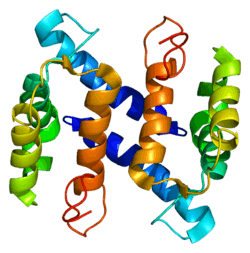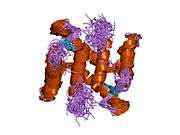S100A4
S100 calcium-binding protein A4 (S100A4) is a protein that in humans is encoded by the S100A4 gene.[5]
Function
The protein encoded by this gene is a member of the S100 family of proteins containing 2 EF-hand calcium-binding motifs. S100 proteins are localized in the cytoplasm and/or nucleus of a wide range of cells, and involved in the regulation of a number of cellular processes such as cell cycle progression and differentiation. S100 genes include at least 13 members which are located as a cluster on chromosome 1q21. This protein may function in motility, invasion, and tubulin polymerization. Chromosomal rearrangements and altered expression of this gene have been implicated in tumor metastasis. Multiple alternatively spliced variants, encoding the same protein, have been identified.[6]
Interactions
S100A4 has been shown to interact with S100 calcium binding protein A1.[7][8]
Therapeutic targeting for cancer
S100A4, a member of the S100 calcium-binding protein family secreted by tumor and stromal cells, supports tumorigenesis by stimulating angiogenesis. Research demonstrated that S100A4 synergizes with vascular endothelial growth factor (VEGF), via the RAGE receptor, in promoting endothelial cell migration by increasing KDR expression and MMP-9 activity. In vivo overexpression of S100A4 led to a significant increase in tumor growth and vascularization in a human melanoma xenograft M21 model. Conversely, when silencing S100A4 by shRNA technology, a dramatic decrease in tumor development of the pancreatic MIA PaCa-2 cell line was observed. Based on these results 5C3 was developed, a neutralizing monoclonal antibody against S100A4. This antibody abolished endothelial cell migration, tumor growth and angiogenesis in immunodeficient mouse xenograft models of MiaPACA-2 and M21-S100A4 cells. It is concluded that extracellular S100A4 inhibition is an attractive approach for the treatment of human cancer.[9]
References
- 1 2 3 GRCh38: Ensembl release 89: ENSG00000196154 - Ensembl, May 2017
- 1 2 3 GRCm38: Ensembl release 89: ENSMUSG00000001020 - Ensembl, May 2017
- ↑ "Human PubMed Reference:".
- ↑ "Mouse PubMed Reference:".
- ↑ Stoler A, Bouck N (March 1985). "Identification of a single chromosome in the normal human genome essential for suppression of hamster cell transformation". Proc. Natl. Acad. Sci. U.S.A. 82 (2): 570–4. doi:10.1073/pnas.82.2.570. PMC 397082. PMID 3155863.
- ↑ "Entrez Gene: S100A4 S100 calcium binding protein A4".
- ↑ Rual JF, Venkatesan K, Hao T, Hirozane-Kishikawa T, Dricot A, Li N, Berriz GF, Gibbons FD, Dreze M, Ayivi-Guedehoussou N, Klitgord N, Simon C, Boxem M, Milstein S, Rosenberg J, Goldberg DS, Zhang LV, Wong SL, Franklin G, Li S, Albala JS, Lim J, Fraughton C, Llamosas E, Cevik S, Bex C, Lamesch P, Sikorski RS, Vandenhaute J, Zoghbi HY, Smolyar A, Bosak S, Sequerra R, Doucette-Stamm L, Cusick ME, Hill DE, Roth FP, Vidal M (October 2005). "Towards a proteome-scale map of the human protein-protein interaction network". Nature. 437 (7062): 1173–8. doi:10.1038/nature04209. PMID 16189514.
- ↑ Wang G, Rudland PS, White MR, Barraclough R (April 2000). "Interaction in vivo and in vitro of the metastasis-inducing S100 protein, S100A4 (p9Ka) with S100A1". J. Biol. Chem. 275 (15): 11141–6. doi:10.1074/jbc.275.15.11141. PMID 10753920.
- ↑ Hernández JL, Padilla L, Dakhel S, Coll T, Hervas R, Adan J, Masa M, Mitjans F, Martinez JM, Coma S, Rodríguez L, Noé V, Ciudad CJ, Blasco F, Messeguer R (September 2013). "Therapeutic targeting of tumor growth and angiogenesis with a novel anti-S100A4 monoclonal antibody". PLOS ONE. 8: e72480. doi:10.1371/journal.pone.0072480. PMC 3762817. PMID 24023743.
Further reading
- Kalluri R, Neilson EG (2003). "Epithelial-mesenchymal transition and its implications for fibrosis". J. Clin. Invest. 112 (12): 1776–84. doi:10.1172/JCI20530. PMC 297008. PMID 14679171.
- Garrett SC, Varney KM, Weber DJ, Bresnick AR (2006). "S100A4, a mediator of metastasis". J. Biol. Chem. 281 (2): 677–80. doi:10.1074/jbc.R500017200. PMID 16243835.
- Tarabykina S, Griffiths TR, Tulchinsky E, Mellon JK, Bronstein IB, Kriajevska M (2007). "Metastasis-associated protein S100A4: spotlight on its role in cell migration". Curr Cancer Drug Targets. 7 (3): 217–28. doi:10.2174/156800907780618329. PMID 17504119.
- Tulchinsky E, Ford HL, Kramerov D, Reshetnyak E, Grigorian M, Zain S, Lukanidin E (1992). "Transcriptional analysis of the mts1 gene with specific reference to 5' flanking sequences". Proc. Natl. Acad. Sci. U.S.A. 89 (19): 9146–50. doi:10.1073/pnas.89.19.9146. PMC 50082. PMID 1329089.
- Engelkamp D, Schäfer BW, Erne P, Heizmann CW (1992). "S100 alpha, CAPL, and CACY: molecular cloning and expression analysis of three calcium-binding proteins from human heart". Biochemistry. 31 (42): 10258–64. doi:10.1021/bi00157a012. PMID 1384693.
- Tomida Y, Terasawa M, Kobayashi R, Hidaka H (1992). "Calcyclin and calvasculin exist in human platelets". Biochem. Biophys. Res. Commun. 189 (3): 1310–6. doi:10.1016/0006-291X(92)90216-8. PMID 1482346.
- Ambartsumian N, Tarabykina S, Grigorian M, Tulchinsky E, Hulgaard E, Georgiev G, Lukanidin E (1995). "Characterization of two splice variants of metastasis-associated human mts1 gene". Gene. 159 (1): 125–30. doi:10.1016/0378-1119(94)00778-Q. PMID 7607566.
- Schäfer BW, Wicki R, Engelkamp D, Mattei MG, Heizmann CW (1995). "Isolation of a YAC clone covering a cluster of nine S100 genes on human chromosome 1q21: rationale for a new nomenclature of the S100 calcium-binding protein family". Genomics. 25 (3): 638–43. doi:10.1016/0888-7543(95)80005-7. PMID 7759097.
- Takenaga K, Nakamura Y, Sakiyama S, Hasegawa Y, Sato K, Endo H (1994). "Binding of pEL98 protein, an S100-related calcium-binding protein, to nonmuscle tropomyosin". J. Cell Biol. 124 (5): 757–68. doi:10.1083/jcb.124.5.757. PMC 2119958. PMID 8120097.
- Pedrocchi M, Schäfer BW, Durussel I, Cox JA, Heizmann CW (1994). "Purification and characterization of the recombinant human calcium-binding S100 proteins CAPL and CACY". Biochemistry. 33 (21): 6732–8. doi:10.1021/bi00187a045. PMID 8204608.
- Engelkamp D, Schäfer BW, Mattei MG, Erne P, Heizmann CW (1993). "Six S100 genes are clustered on human chromosome 1q21: identification of two genes coding for the two previously unreported calcium-binding proteins S100D and S100E". Proc. Natl. Acad. Sci. U.S.A. 90 (14): 6547–51. doi:10.1073/pnas.90.14.6547. PMC 46969. PMID 8341667.
- Ford HL, Silver DL, Kachar B, Sellers JR, Zain SB (1997). "Effect of Mts1 on the structure and activity of nonmuscle myosin II". Biochemistry. 36 (51): 16321–7. doi:10.1021/bi971182l. PMID 9405067.
- Liu JH, Wei S, Burnette PK, Gamero AM, Hutton M, Djeu JY (1999). "Functional association of TGF-beta receptor II with cyclin B". Oncogene. 18 (1): 269–75. doi:10.1038/sj.onc.1202263. PMID 9926943.
- Wang G, Rudland PS, White MR, Barraclough R (2000). "Interaction in vivo and in vitro of the metastasis-inducing S100 protein, S100A4 (p9Ka) with S100A1". J. Biol. Chem. 275 (15): 11141–6. doi:10.1074/jbc.275.15.11141. PMID 10753920.
- Tarabykina S, Kriajevska M, Scott DJ, Hill TJ, Lafitte D, Derrick PJ, Dodson GG, Lukanidin E, Bronstein I (2000). "Heterocomplex formation between metastasis-related protein S100A4 (Mts1) and S100A1 as revealed by the yeast two-hybrid system". FEBS Lett. 475 (3): 187–91. doi:10.1016/S0014-5793(00)01652-5. PMID 10869553.
- Tarabykina S, Scott DJ, Herzyk P, Hill TJ, Tame JR, Kriajevska M, Lafitte D, Derrick PJ, Dodson GG, Maitland NJ, Lukanidin EM, Bronstein IB (2001). "The dimerization interface of the metastasis-associated protein S100A4 (Mts1): in vivo and in vitro studies". J. Biol. Chem. 276 (26): 24212–22. doi:10.1074/jbc.M009477200. PMID 11278510.
- Grigorian M, Andresen S, Tulchinsky E, Kriajevska M, Carlberg C, Kruse C, Cohn M, Ambartsumian N, Christensen A, Selivanova G, Lukanidin E (2001). "Tumor suppressor p53 protein is a new target for the metastasis-associated Mts1/S100A4 protein: functional consequences of their interaction". J. Biol. Chem. 276 (25): 22699–708. doi:10.1074/jbc.M010231200. PMID 11278647.
- Chen H, Fernig DG, Rudland PS, Sparks A, Wilkinson MC, Barraclough R (2001). "Binding to intracellular targets of the metastasis-inducing protein, S100A4 (p9Ka)". Biochem. Biophys. Res. Commun. 286 (5): 1212–7. doi:10.1006/bbrc.2001.5517. PMID 11527429.
- Zhang H, Wang Z, Ding Y, Wang G, Wang X, Bartlam M, Tang H, Liu Y, Jiang F, Barraclough R, Rudland PS, Rao Z (2002). "Crystallization and preliminary crystallographic analysis of a metastasis-inducing protein, human S100A4". Acta Crystallogr. D. 58 (Pt 1): 127–9. doi:10.1107/S090744490101650X. PMID 11752788.






